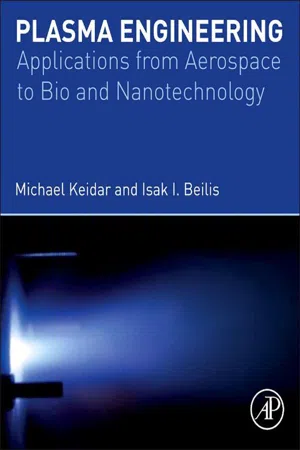
Plasma Engineering
Applications from Aerospace to Bio and Nanotechnology
- 424 pages
- English
- ePUB (mobile friendly)
- Available on iOS & Android
About this book
Plasma Engineering is the first textbook that addresses plasma engineering in the aerospace, nanotechnology, and bioengineering fields from a unified standpoint. It covers the fundamentals of plasma physics at a level suitable for an upper level undergraduate or graduate student, and applies the unique properties of plasmas (ionized gases) to improve processes and performance over a wide variety of areas such as materials processing, spacecraft propulsion, and nanofabrication.The book starts by reviewing plasma particle collisions, waves, and instabilities, and proceeds to diagnostic tools, such as planar, spherical, and emissive probes, and the electrostatic analyzer, interferometric technique, and plasma spectroscopy. The physics of different types of electrical discharges are considered, including the classical Townsend mechanism of gas electrical breakdown and the Paschen law. Basic approaches and theoretical methodologies for plasma modeling are described, based on the fluid description of plasma solving numerically magnetohydrodynamic (MHD) equations and the kinetic model particle techniques that take into account kinetic interactions among particles and electromagnetic fields. Readers are then introduced to the widest variety of applications in any text on the market, including space propulsion applications and application of low-temperature plasmas in nanoscience and nanotechnology. The latest original results on cold atmospheric plasma (CAP) applications in medicine are presented. The book includes a large number of worked examples, end of chapter exercises, and historical perspectives. There is also an accompanying plasma simulation software covering the Particle in Cell (PIC) approach, available at http://www.particleincell.com/blog/2011/particle-in-cell-example/.This book is appropriate for grad level courses in Plasma Engineering/Plasma Physics in departments of Aerospace Engineering, Electrical Engineering, and Physics. It will also be useful as an introduction to plasma engineering and its applications for early career researchers and practicing engineers.- The first textbook that addresses plasma engineering in the aerospace, nanotechnology, and bioengineering fields from a unified standpoint- Includes a large number of worked examples, end of chapter exercises, and historical perspectives- Accompanying plasma simulation software covering the Particle in Cell (PIC) approach, available at http://www.particleincell.com/blog/2011/particle-in-cell-example/
Frequently asked questions
- Essential is ideal for learners and professionals who enjoy exploring a wide range of subjects. Access the Essential Library with 800,000+ trusted titles and best-sellers across business, personal growth, and the humanities. Includes unlimited reading time and Standard Read Aloud voice.
- Complete: Perfect for advanced learners and researchers needing full, unrestricted access. Unlock 1.4M+ books across hundreds of subjects, including academic and specialized titles. The Complete Plan also includes advanced features like Premium Read Aloud and Research Assistant.
Please note we cannot support devices running on iOS 13 and Android 7 or earlier. Learn more about using the app.
Information
1.1 Introduction
Table of contents
- Cover image
- Title page
- Table of Contents
- Dedication
- Copyright
- Preface
- Chapter 1. Plasma Concepts
- Chapter 2. Plasma Diagnostics
- Chapter 3. Electrical Discharges
- Chapter 4. Plasma Dynamics
- Chapter 5. Plasma in Space Propulsion
- Chapter 6. Plasma Nanoscience and Nanotechnology
- Chapter 7. Plasma Medicine
- Appendix. Physical Constants in SI
- Index